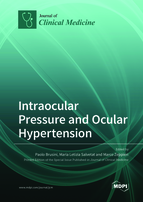Intraocular Pressure and Ocular Hypertension
A special issue of Journal of Clinical Medicine (ISSN 2077-0383). This special issue belongs to the section "Ophthalmology".
Deadline for manuscript submissions: closed (10 June 2022) | Viewed by 48398
Special Issue Editors
Interests: intraocular pressure; tonometry; ocular hypertension; glaucoma; cornea; paediatric ophthalmology
Interests: glaucoma; general ophthalmology; intraocular pressure; tonometry; mesenchymal stem cell; eyes; visual fields; clinical ophthalmology
Special Issues, Collections and Topics in MDPI journals
Special Issue Information
Dear Colleagues,
Primary open-angle glaucoma (POAG) is a multi-factorial progressive optic neuropathy characterized by retinal ganglion cell degeneration and progressive visual field loss that, if left untreated, may lead to blindness. Increased intraocular pressure (IOP) is considered the main risk factor for developing POAG, and its reduction has been shown to correlate with a decrease in glaucoma incidence and progression. Despite all the advances, all the current methods used to measure the IOP are influenced by various factors so that they can only provide an IOP estimation. Considering that less than 10% of the subjects with ocular hypertension (OHT) will develop morphological and/or functional glaucomatous damages within 5 years if not treated, glaucoma causes and molecular changes leading to ocular tissue damage in glaucoma are still largely unknown. Treatment of POAG is nowadays mainly oriented towards reducing IOP; the importance of the IOP reduction in other types of glaucoma, such as the “normal pressure glaucoma”, is still discussed. Since the IOP value is maintained by balancing the amount of fluid contained within the anterior and posterior chambers of the eye, our comprehension of the mechanisms underlying the secretion and active and passive outflow of the acqueous humor is extremely important for improving the treatment of glaucoma. Innovative pharmacological approaches, and laser and surgical procedures aiming to reduce IOP, have been developed in recent years.
This Special Issue provides a compendium of topics relevant to the study of IOP, acqueous humor dynamic, IOP measurement, and medical and surgical techniques developed to reduce the IOP in subjects with ocular hypertension or glaucoma.
Dr. Maria Letizia Salvetat
Dr. Marco Zeppieri
Dr. Paolo Brusini
Guest Editors
Manuscript Submission Information
Manuscripts should be submitted online at www.mdpi.com by registering and logging in to this website. Once you are registered, click here to go to the submission form. Manuscripts can be submitted until the deadline. All submissions that pass pre-check are peer-reviewed. Accepted papers will be published continuously in the journal (as soon as accepted) and will be listed together on the special issue website. Research articles, review articles as well as short communications are invited. For planned papers, a title and short abstract (about 100 words) can be sent to the Editorial Office for announcement on this website.
Submitted manuscripts should not have been published previously, nor be under consideration for publication elsewhere (except conference proceedings papers). All manuscripts are thoroughly refereed through a single-blind peer-review process. A guide for authors and other relevant information for submission of manuscripts is available on the Instructions for Authors page. Journal of Clinical Medicine is an international peer-reviewed open access semimonthly journal published by MDPI.
Please visit the Instructions for Authors page before submitting a manuscript. The Article Processing Charge (APC) for publication in this open access journal is 2600 CHF (Swiss Francs). Submitted papers should be well formatted and use good English. Authors may use MDPI's English editing service prior to publication or during author revisions.
Keywords
- Intraocular pressure dynamics: pathophysiology of acqueous humor inflow and outflow
- Intraocular pressure measurement: conventional and new techniques
- Ocular hypertension: main risk factor for glaucoma development
- Ocular hypertension treatment: conventional and new pharmacological, laser, and surgical techniques for ocular hypertension management.








